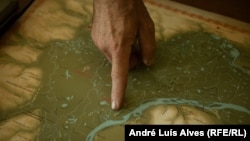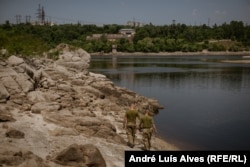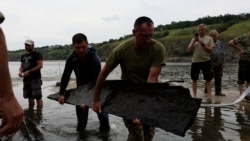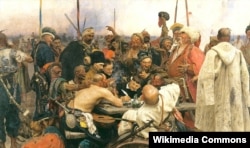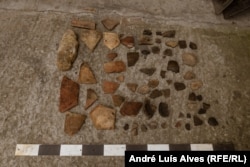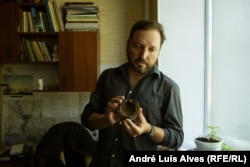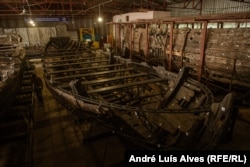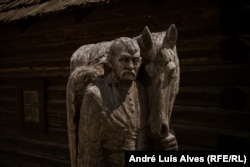KHORTYTSIA ISLAND, Ukraine -- The mighty Dnieper River flowed steadily past this ancient island for decades -- until the breach of a major dam downstream sucked the water away last month, exposing flats of mud and shells littered by remnants of the past, both recent and distant.
The destruction of the Russian-held Kakhovka dam on June 6 led to massive flooding downriver and drained an enormous reservoir upriver almost dry, causing a humanitarian and ecological disaster across a large swath of southern Ukraine.
The breach may have slowed a Ukrainian counteroffensive against invading Russian forces by preventing a possible assault on their positions on the eastern bank of the Dnieper. Kyiv has blamed the destruction of the dam on Russia, which has controlled the structure for some 16 months, and journalistic investigations suggest that Russia blew it up from the inside.
The receding water has also uncovered what is sometimes called the "Cossack Atlantis" -- lands that had been home to Zaporizhian Cossacks, steppe warriors who had formed a polity known as the Zaporizhian Sich between the 16th and 18th centuries, long before the area was inundated when the Soviet Union built the Kakhovka dam in 1956.
'Archaeological Boom'
The Kakhovka dam was part of a system of dams, reservoirs, and hydroelectric power plants built by the Soviet Union along the Dnieper to prevent uncontrolled flooding, improve transportation on the river that bisects Ukraine, and produce energy. Multiple villages, churches, and historical sites were sunk completely under water due to its construction.
Carried out mostly during the Cold War, the project involved a dose of military planning, because blowing up the dams could create a difficult barrier for a potential invading force at any given moment. It had happened twice during World War II: In 1941, the Soviet Union blew up the Dnieper Hydroelectric Station in Zaporizhzhya to slow the Nazi advance; the Germans rebuilt it and blew it up again in 1943 in a bid to stop the Soviet counteroffensive.
Following the June 6 breach, after the water receded as much as 4 meters, fortune-seekers known as "black archaeologists" or "diggers" -- people illegally collecting artifacts, usually to sell them -- found a skull with a Nazi helmet and other items from the last armed conflict to have swept over the region until February 2022, when Russia launched its full-scale invasion of Ukraine, an unprovoked assault that unleashed the biggest war in Europe since 1945.
The remnants of a temporary bridge built in 1944 emerged from the water in the city of Zaporizhzhya.
The drying up of the Kakhovka reservoir could bring an "archaeological boom" in the future, Oleh Tuboltsev, a researcher at the Khortytsia National Reserve and founder of the New Archaeological School in Zaporizhzhya, told RFE/RL. For now, most of the newly exposed territory is unavailable to researchers because Russian forces occupy most of the reservoir's left or eastern bank -- but new findings are made every day.
The Ukrainian government has already approved a resolution on a project to rebuild the Kakhovka dam -- a step necessary for feeding the region with water but possible only if Russian troops retreat. Archeologists say they have no time to lose and argue that scientific research needs to be included in the project.
One of the most spectacular findings so far is an approximately 500 years old 7-meter-long wooden boat. It was painstakingly removed from the river with the help of maritime archaeologists who traveled to Zaporizhzhya during a break from their duty as soldiers at the front, Tuboltsev said.
For centuries the Dnieper River was the central element of the trade that connected Scandinavia, Kyivan Rus, and the Eastern Roman Empire. In early modern and modern times, Ukraine's biggest river defined much of its history due to its economic and military significance.
Khortytsia, the biggest island on the river, was historically located beneath the Dnieper Rapids that allowed for river crossings and above the so-called Velykiy Luh, or Great Meadow, which offered a hospitable microclimate in an otherwise dry steppe environment. It played an important role for successive peoples inhabiting it over the past five millennia.
Since the breach, archaeologists working on the island have found ceramics from the Bronze Age and the era of the ancient Greeks, most likely brought here from Crimea, artifacts related to Kyivan Rus and Crimean Tatar trading, and parts of ships and weapons from the times of Cossacks and the Russian Empire, Anatoliy Volkov, a researcher at the Khortytsia National Reserve, told RFE/RL.
Cossacks Reconsidered
The receding water in the reservoir -- a long, broad stretch of the Dnieper -- uncovered the territory of Velykiy Luh, where the Zaporizhian Cossacks built at least eight fortified settlements, called siches, from the mid-16th century until the late 18th century. But until the fighting is over in the region, Volkov said, those and other promising archaeological sites -- such as Tatar settlements and Scythian kurgans, or burial mounds -- won't be available for research.
It was in this historically important region where the Khmelnytsky Uprising against the Polish domination began in 1648, and many believe it was here where Cossacks wrote their notorious letter refusing loyalty to the Ottoman Sultan Mehmed IV -- a scene depicted by the 19th-century painter Ilya Repin.
The legacy of Zaporizhian Sich, a proto-state organized as a military democracy and created by Cossacks who were fighting against Crimean Tatars, Ottoman Turks, Poles, and Russians, has been increasingly important for the Ukrainian national identity, Mykola Svydran, a historian working at the Museum of Zaporizhian Cossacks, told RFE/RL.
The construction of the museum was possible due to looser policies during the period known as the thaw, under Soviet leader Nikita Khrushchev, but its directors later faced criticism from Soviet authorities over allegations of nationalism.
Today, Russia's aggression against Ukraine is changing the popular perception of the Zaporizhian Cossacks, which before the war was largely shaped by Russian historiography, Svydran said. "Instead of viewing them as defenders of Orthodoxy, we now understand the deep links they had with Polish and Tatar culture and see them primarily as forefathers of Ukrainian independence."
The Zaporizhian Sich was disbanded by Russian Empress Catherine the Great in 1775, and its territory was incorporated into the Russian province of Novorossiya. From then on, Cossacks, who lost their autonomy, took part in Russia's wars, most importantly against the Ottoman Empire.
The 18th-century conquest of the Azov Sea coast and Crimea has been repeatedly used by Russian propagandists and President Vladimir Putin to justify the Russian seizure of the Crimean Peninsula in 2014 and parts of the Zaporizhzhya, Kherson, Luhansk, and Donetsk regions -- none of which Russian forces fully controls -- in September 2022.
The archaeologists and historians working at Khortytsia Island have found and restored some Cossack ships that were used in those campaigns. Andriy Denysenko, a researcher and restorer working on the preservation of the wooden structures, showed RFE/RL a 10-ton cannon from the 18th century -- the biggest model in the Russian Empire at that time -- found by his colleagues under the sand at the bottom of the river.
"They are pounding our city with missiles, and we are restoring the historical Dnieper flotilla," he said.
Wartime Archaeology
The city of Zaporizhzhya, just 35 kilometers from the front line, has been slammed by missiles and drones since the first day of Russia's full-scale invasion 17 months ago. Dozens of people have been killed in the attacks, and numerous buildings have been damaged or destroyed. Khortytsia Island has been hit by 21 missiles, according to employees of the national reserve.
Most of the Zaporizhzhya region still remains under Russian occupation despite grinding battles ongoing around the towns of Orikhiv and Hulyaypole. Ukrainian investigative authorities have opened 2,430 criminal proceedings involving suspected war crimes by Russia and its soldiers against Ukraine, its military, and civilians.
Russia has built an extensive system of fortifications and land mines on the occupied territory that is slowing Ukraine's effort to reconquer it. According to Tuboltsev, who studied satellite photos, this network is "much bigger than in 1943" and hundreds of archaeological sites, including "almost all the big Scythian kurgans," were destroyed during its construction.
The destruction of Ukraine’s cultural heritage by Russia goes far beyond that. According to the Ukrainian Culture Ministry, nearly 40 museums in Ukraine have been looted since the beginning of the full-scale invasion and thousands of treasures have been plundered.
Among them is a 1,500-year-old tiara -- one of the world's most valuable artifacts from the fifth-century rule of Attila the Hun -- that was stolen from a museum in the Russian-held southern city of Melitopol along with among 1,700 other artifacts. As many as 2,000 items have been looted from a museum in Mariupol, which Russian forces captured in May 2022 after months of brutal attacks that obliterated much of the Azov Sea coast city.
When Russia launched the full-scale invasion, Tuboltsev, who is now 55, did not abandon his labors. Fearing that "decades of work were at risk," he said, he decided to complete a catalog of archaeological artifacts found in the region. The son of a Russian engineer and, according to his Ukrainian passport, an ethnic Russian, he decided to fully switch to speaking Ukrainian, including in his private life.
Many of his students joined the military, and some colleagues are under occupation. He said that he has corrected fire for the Ukrainian military multiple times in two occupied cities and a village, drawing on his back-of-the-hand familiarity with the regional geography and ties within the occupied communities.
"Before the invasion, there was a lot of pro-Russian sentiment in the region," Tuboltsev said. "But for all the progressive circles in Zaporizhzhya it has been clear for many years that the future belongs to Ukraine, its language, and its culture."




